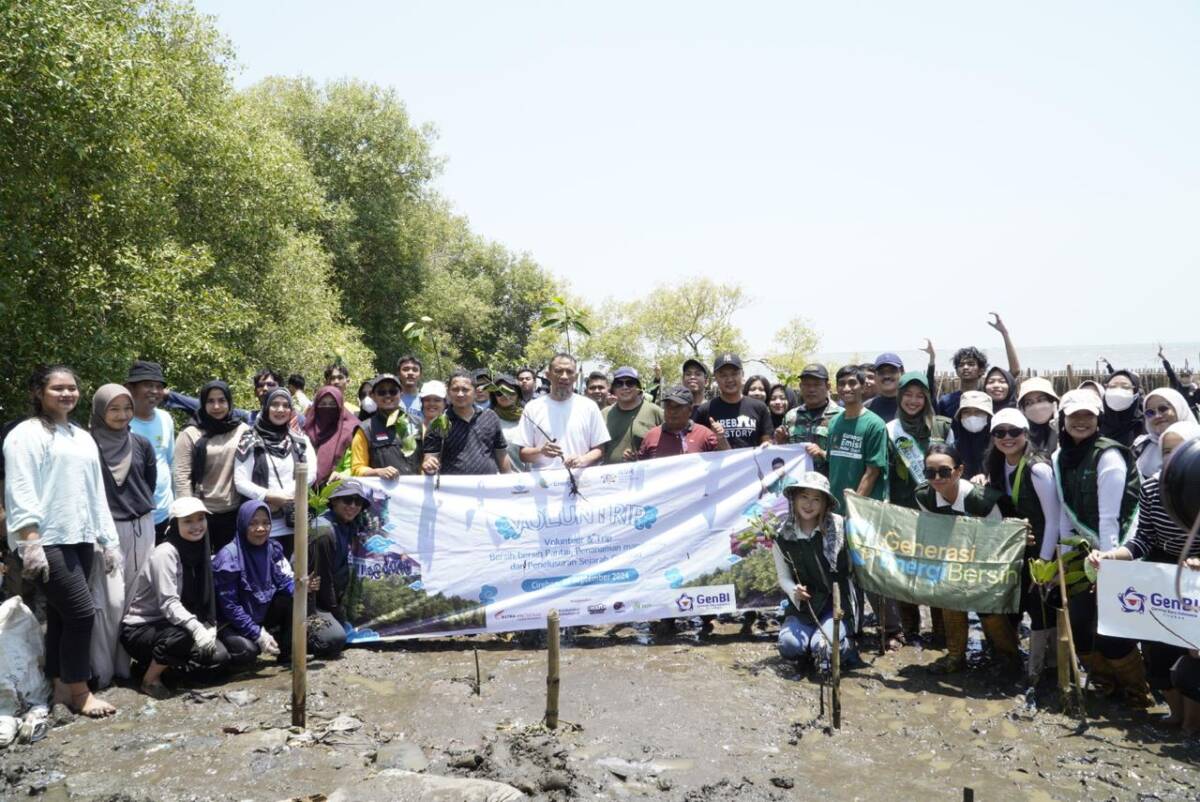Cirebon, September 28, 2024- RW 09 Kesunean Selatan has a mangrove forest area of 7.5 hectares, which can serve as a natural fortress that protects the area from flooding and tidal floods. However, the area continues to shrink due to other pressures, such as clearing paths to the sea, cutting down trees, and expanding settlements by piling up garbage to make new land. To preserve the mangrove forest, the residents of RW 09 took the initiative to develop it as an ecotourism area that can provide economic benefits for the residents, and built a bridge that is expected to prevent tree cutting due to the opening of paths to the sea.
Mangrove forest conservation is in line with efforts to reduce greenhouse gas emissions. Mangrove trees are very effective at storing carbon. One hectare of mangrove forest can store 27 to 38 tons of carbon per year, which is higher than other types of forests. In addition to storing carbon and protecting the coast from abrasion, mangroves have other benefits, such as maintaining the biodiversity of marine biota, serving as fish nurseries to increase fish stocks, filtering pollutants from seawater, and providing socio-economic benefits for communities that maintain their sustainability.
Based on this, the Institute for Essential Services Reform (IESR) and Generasi Energi Bersih (GEN-B) support mangrove conservation initiatives through the Sustainable Emission Reduction Initiative (SERI) project.
The Executive Director of IESR, Fabby Tumiwa said that ecosystem protection and restoration and nature conservation should provide economic incentives and direct benefits to the community. The establishment of mangrove tourism areas is a mangrove ecosystem restoration strategy that provides economic benefits to the community through the creation of new sources of income and employment.
“A well-maintained mangrove forest will be more effective in absorbing and storing carbon and protecting the area from abrasion, as well as being a supportive habitat for marine animals. Mangrove conservation and restoration can prevent the increase of greenhouse gases, which today have caused a rise in earth’s temperature, which triggers rising sea levels and increases the frequency and intensity of tidal floods,” Fabby explained at the Waste Cleanup and Mangrove Seedling Planting Activity for Sustainable Mangrove Area Preservation organized by IESR, GEN-B Indonesia, GEN-B Cirebon, Cirebon City Government and RW 09 South Kesunean (28/09/2024).
Chairman of RW 09, Pepep Nurhadi, said that his party has been taking care of the mangrove forest area since 2003, and has felt the benefits such as avoiding tidal flooding, landfill to expand the area, and safety of coastal settlements from abrasion.
“The development of ecotourism accompanied by the construction of this bridge is expected to reduce the damage to the mangrove ecosystem. However, the construction requires costs that can be supported through cooperation with many parties,” he said.
Furthermore, Pepep explained that the idea of establishing a mangrove ecotourism area has received support from the Women’s Role Improvement Program Towards Healthy Family Welfare (P2WKSS) team, the Cirebon City Office of Women’s Empowerment, Child Protection, Population Control and Family Planning, DP3APPKB, the Environmental Service (DLH), and other Cirebon City agencies. In addition, Kasepuhan Village and Lemahwungkuk District, Cirebon City, are also committed to the preservation of the South Kesunean mangrove area.
Maya Lynn, National Chairperson of GEN-B Indonesia, is determined to collaborate with companies and various parties to realize ecotourism and bridge building. According to her, with the increasing public awareness of emission reduction efforts and green products, companies, groups, and individuals can use this mangrove maintenance project to redeem their carbon emissions (carbon offset).
This commitment is also supported by the Chairperson of GEN-B Cirebon, Adji Annisa Rahmadina, who is also involved in mobilizing collaboration.
“The current collaboration is in the form of fundraising for mangrove ecotourism. Of course, carbon offsetting actions also need to go hand in hand with cutting emission production by switching to renewable energy and taking other emission reduction steps,” said Adji Anissa.
Also present at the event were representatives of Kasepuhan Village, Lemahwungkuk Subdistrict, DP3APPKB, DLH, the Department of Cooperatives, Small and Medium Enterprises and Trade (DKUKMPP), the Cirebon City Public Housing and Settlement Area Office (DPRKP).

